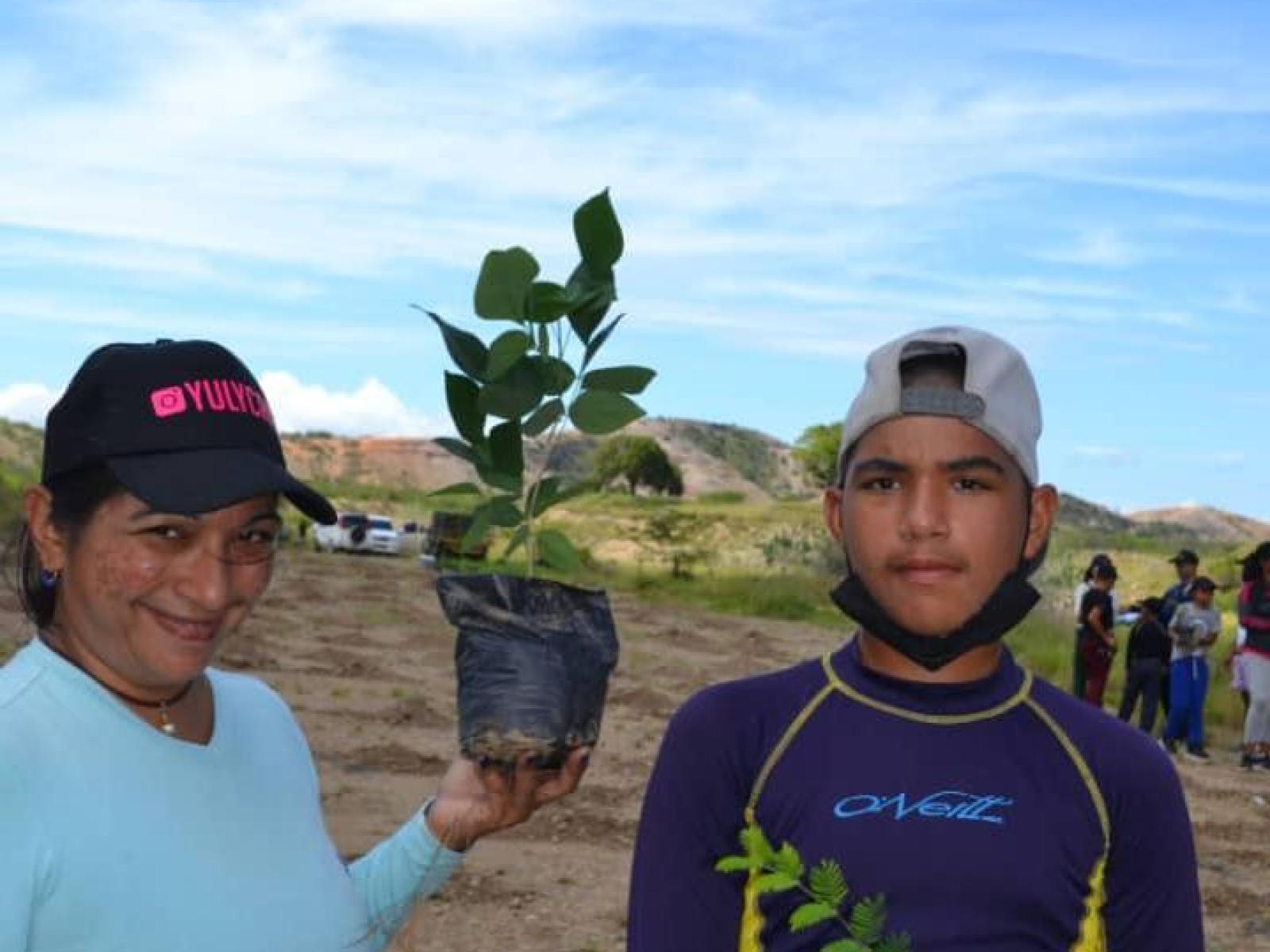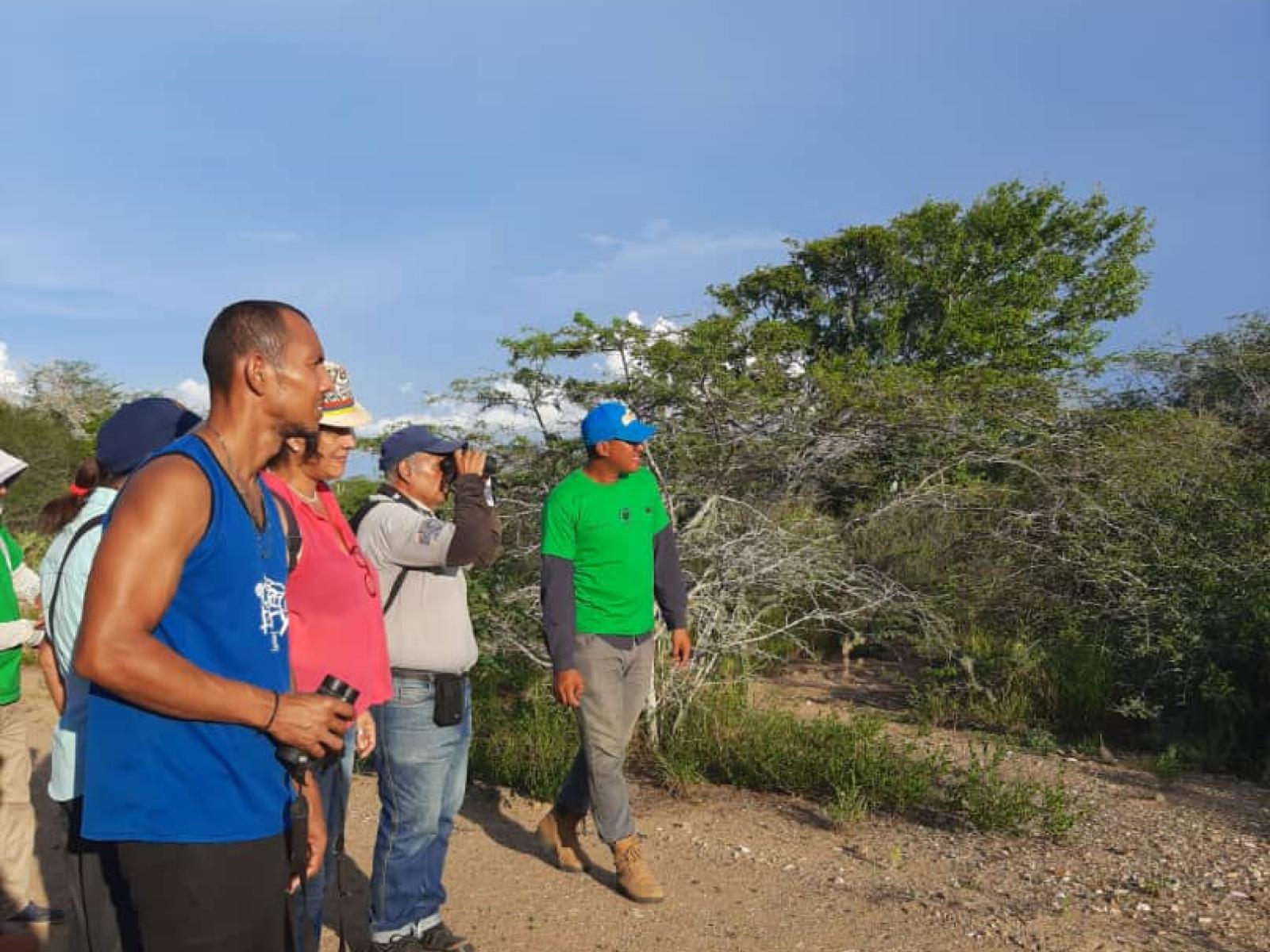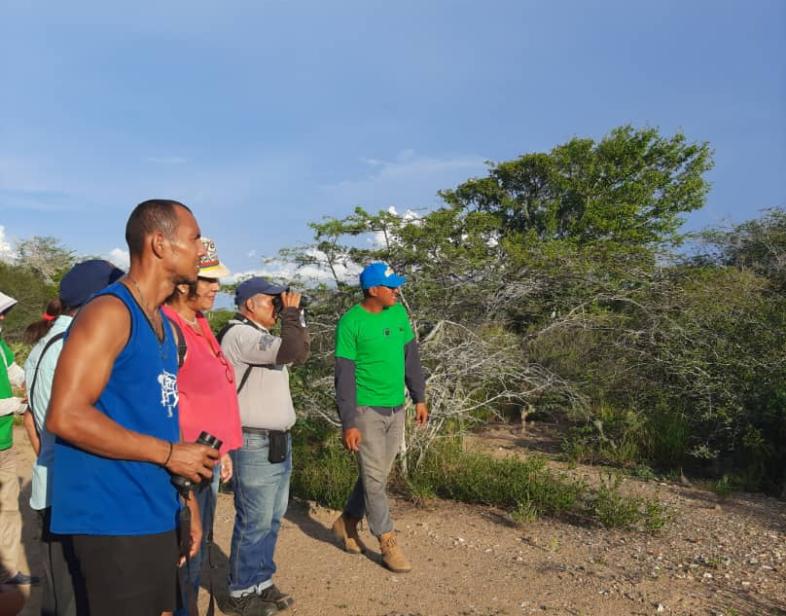An Overview Of Our Solution
The Yellow-shouldered Amazon is an endangered species highly demanded in Macanao, Venezuela. Women use parrots to manage loneliness, playing a key role in their demand. Green Sky promotes outdoor activities as a way for enjoying birds without keeping them captive. It targeted women aged 30-50 in two communities in Macanao. An evidence-based audience segmentation, alternative behavior evaluation, and a Theory of Change was developed. Impact is being measured with a before-after-control-intervention approach. We implemented core and communication activities with the help of > 20 local partners. 96% of participants had positive perceptions of the activities, with high interest in future participation (69%). Participation of youth and seniors increased from 0 to 10-14%. Communications reached 22% of the total population. Impact will be assessed by Oct 2023.
- Population Impacted: 5,540 social media accounts reached (22% of total population in focal communities); 380 participants in core activities (2% of total population in focal communities)
- Continent: South America
First name
Last name
Organization type
Email Address
Context Analysis
The Yellow-shouldered Amazon (YSA, Amazona barbadensis) is a species listed as "Endangered" in Venezuela and included in the Appendix I of CITES. These birds are predominantly found on Macanao, Margarita Island, where up to 30% of the population keep YSA as pets. The primary drivers of YSA demand are misguided affectionate attitudes towards parrots and a misperception of the benefits of human protection. Women play a significant role in the illegal trade of these birds. The absence of fathers, sons, and husbands during long fishing trips can lead to feelings of loneliness in women, and parrots are often used to manage these emotions. They are viewed as "part of the family" and are given as gifts to alleviate loneliness. Despite high levels of knowledge about parrot biology and conservation issues among Macanao communities, people with higher levels of education have a higher intention to keep YSA as pets, indicating that knowledge is used to reinforce misguided empathy, rather than to change behavior and reduce demand.
Any intervention to reduce demand of YSA in Macanao should consider two important contextual factors in Macanao’s communities: 1) widespread poverty, and 2) prevalence of adult women, mostly single mothers. High unemployment and low educational level is prevalent in Macanao communities, but the impact of poverty in parrots demand goes beyond the economic realm: is defined by lack of power and voice. In Macanao, women’s participation in the social functions, including conservation programs, is hampered by the mental stress created by loneliness and the increased responsibility of looking for food, medicine and basic resources. Jointly with the lack of working opportunities, this situation makes them not only more dependent on male support and government social help, but poorer in terms of empowerment and participation.
Describe the technical solution you wanted the target audience to adopt
The behavior having the most detrimental impact on YSA demand is a misguided affectionate attitude towards parrots.Therefore, the behavioral shift needed is for people to engage in sustainable use of parrots that allow people to continue enjoying the companionship of parrots without keeping them captive. Gaining this engagement will require much more than increasing knowledge or promoting pro-environmental values or attitudes. It will be also necessary to overcome psychological (apathy) and social (wildlife-consuming social norms) barriers to adopt the alternative behavior. So, more than environmental education campaigns, we propose that a behavior change campaign will be more appropriate for helping people to overcome such barriers, so that positive attitudes toward YSA conservation could drive actions that would generate the change required: in the medium term, reduce the demand for YSA, and in the long term, their illegal trade.
Describe your behavioral intervention.
The behavior change campaign, Cielo Verde (Green Sky), promotes social norms and positive attitudes towards outdoor activities as a way to enjoy birds without keeping them captive. The campaign satisfies fundamental motivations and desires, while reducing the perception that pet keeping is necessary.
Based on evidence from baseline research, workshops, and discussion with the communities, we segmented the audience, evaluated different alternative behaviors, and built a Theory of Change. The campaign runs from June 2022 - October 2023 in two treatment Macanao’s communities (Robledal and Boca de Pozo; 12,000 people each) and targets non-professional adults and young adult professionals, mainly women aged 30-50. The campaign includes core and communication activities. Core activities include bird watching, interpretive trails, and conservation management experiences (e.g. building artificial nests, bird banding) provides direct bird encounters and informs of personal and benefits of adopting alternative behaviors. Communicational activities comprise publications in social media (Facebook and Instagram), WhatsApp groups, and flyers. Our messaging approach is to avoid a patronising conservationist tone and instead, emphasise the cultural and social values that the Macanao communities hold for parrots. Our messaging strategy emphasises the advantages of engaging in outdoor activities such as positive impact on health, and strengthening families ties.
Behavioral Levers Utilized
As needed, please explain how you utilized the lever(s) in more detail.
Information & Material Incentives: Our videos and posts illustrate how people could enjoy parrots without keeping them as pets. We provide information on the objectives, dates, and locations of core activities, emphasizing their amusing, family-friendly nature and availability of transportation to overcome barriers to participation. We run parallel recreational sessions for kids and shorter activities for seniors.
Emotional Appeals: With drone shots of vast landscapes and people enjoying the outdoors with background sounds of parrots and wind, we evoke the feeling of flying and joy. Our messages and scripts use the PEEL strategy and are narrated by a popular local female singer. Our communication style is personalized, empathetic, and inspirational. We use local idioms when possible.
Social Influences: Local comedians serve as trendsetters promoting participation and fun perception. We use testimonials from community members to highlight their experience and shared problems.
Describe your implementation
Provita is now capitalizing > 30 years of working hand in hand with local organizations and leaders. The yellow-shouldered Amazon Conservation Program in Macanao has influenced both positive relations between conservation practitioners and local communities, as well as positive perceptions and attitudes towards YSA conservation. People recognize the leading role of Provita, which is now translating into trust and commitment of formerly reticent stakeholders. Youth and seniors in Macano, before indifferent, are now eagerly participating in campaign activities.
A key success factor was that we were able to engage local communities through staff recruitment, community brainstorming workshops, and a volunteer program, enabling incorporation of the local perspective in the diagnosis and solutions, as well as identifying implementation opportunities and barriers.
We faced two main barriers to adopt the proposed behavior: apathy and perception that outdoor activities are boring. We held a brainstorming workshop with representatives from cultural, education, conservation, and government sectors of treatment communities. The workshop allowed us to identify and design core activities that align with campaign objectives, were enjoyable for the audience, and were easy to implement based on our current resources, technical capacities, and logistics.
Describe the leadership for your solution. Who is leading the implementation?
Our small core team of eight is composed of 2 biologists, 1 communicator, 1 graphic designer, 1 educator, 1 ecologist & data analysts, and 1 manager (5.5 FTE full-time equivalent), with 62% of female representation. Our extended team in Provita includes the staff from the Yellow-shouldered Conservation Program, Ecoguardians (Provita’s local team of rangers), and Provita’s Communications and Environmental Directions. Ours is a youth team (with 60% of the staff under 30 years old) of early careers or with recent degrees in their respective areas.
We involved local institutions and individuals in the development of the Theory of Change and identification core activities, through meetings, discussions sessions, and by incorporating local people into our staff.
Share some of the key partners or stakeholders engaged in your solution development and implementation.
Partners from the government bodies sector (the Mayor of Macanao Peninsula Council, the director of the Environment Office of the Macanao Peninsula Council, the president of Nueva Esparta Tourism Corporation, and rangers from the National Parks Institute) provided us logistic support for activities implementation.
Partners from the educational institutions sectors (the principal of the primary school Antonio José de Sucre, the principal of the preschool Luz del Faro, the principal of primary school Francisco Antonio García, and directors of the Boca de Pozo and Robledal public libraries) support with venues for core activities and helped us to identify and prioritize them.
Private tourism enterprises like MacanaoTrekking, advised us on bushwalking and group management, while Hacienda Macanao offered us locations to hold our events.
Religious institutions like the Catholic priest from Boca del Río encouraged participation and spread campaign messages.
Community-based organizations like Asomayor seniors club in Robledal, Damas Otoñales senior club in Boca de Pozo, the Venezuelan-American Center of Margarita Island, promoted participation and disseminated campaign messages.
Our partners from the Rural Finance Foundation helped us verify that tone, language and complexity in our questionnaires were in accordance with social and cultural context, and identify local women to conform the interviewers crew.
Expert in environmental and social behavior from Universidad Simón Bolívar, provided us with useful recommendations to improve our questionnaire and analysis approaches.
Our international partners ( IUCN-NL, the Smithsonian Institution - National Zoo & Conservation Biology Institute) and advisors (Allan Crawford & Gayle Burgess - TRAFFIC, Simon Bruslund- EAZA Silent Forest Campaign, and Joaquin De la Torre - IFAW), helped us enhance and strengthen our regional collaboration network in Latin America and provide insightful recommendations.
Video file
Who adopted the desired behavior(s) and to what degree? Include an explanation of how you measured a change in behavior.
We conducted interviews before campaign launch, with 362 participants in treatment and control communities, assessing demand and behavior indicators. Intention to acquire YSA was low (72% > unlikely). 17% of interviewees reported keeping YSA. Perception of parrots as part of the family was predominant (82%). Poaching prevalence was low (3%), reflecting the changing social context. Intentions and perceived control to adopt alternative behaviors were prevalent (>70%), but social norms toward adoption were mixed (47%). Participation in core activities increased from 28 adult women to 380 (72% women). The majority of participants (69% of 151 interviews) had high interest in future participation. We reached 5,420 Facebook accounts (22% of the total population). We plan to measure demand and behavior indicators in Oct 2023, expecting to observe similarly low values of demand intentions and keeping of YSA, but higher prevalence of social norms supporting the alternative behavior.
How did you impact the environment (biodiversity conservation, ecosystems, etc.)? Please be specific and include measurement methodology where relevant.
By October 2023, our campaigns will reduce demand for YSA in Macanao and encourage local engagement in sustainable practices. Measurable indicators include:
Intentions to acquire YSA in the target audience, as measured through interviews, are expected to remain low in 2023, similar to the values observed in 2022.
In 2023, we expect a 10% increase in perceived social norms and control in focal audiences, as measured through interviews, compared to the baseline level in 2022.
In 2023 YSA nest poaching rate in unsurveilled sites will be 0 compared to the baseline level in 2022 (3%). We surveyed two unsurveilled nesting sites in Macanao. detecting 48 cavities, 77% of them with potential to become a parrot nest. Of these potential nests, 19% were active, and only one showed evidence of poaching activity. The poaching prevalence was 3%. We plan to do another nest poaching survey in the same sites in May 2023.
How has your solution impacted equity challenges (including race, ethnicity, social class/income, indigenous communities, or others)?
To diversify our audience, we targeted youth, senior and adult male participants, who were underrepresented in our initial activities dominated by adult women. As a result, youth females and males now account for 7% and 10% of total participants, respectively. While adult women continue to dominate with 57%, adult male participation increased from 0% to 43%. Seniors in both genders also saw an increase in representation, now comprising 10 - 14% of our participants.
What were some social and/or community co-benefits?
Our campaign improved community capacities, through a one-day workshop covering birdwatching best practices. We will hold another in April 2023 to improve guiding skills. Also, people feel more empowered and self-organise preparing snacks and meals for activities and identifying bird watching sites near their homes. Increased skills and empowerment will help communities organise independent outdoor activities and support our way-out and scaling up strategy in other communities.
What were some sustainable development co-benefits?
We created an interpretive trail in the Chacaracual Community Conservation Area, consisting of a 2 km circuit with 5 stops that highlights the positive impacts of nature on personal wellbeing (reduce stress, improve physical conditions). We will operate it in partnership with Macanao Trekking, a private ecotourism enterprise. We expect that in the short to medium term private tours could be an additional source of income for the people from the communities who are capacitated as guides
Sustainability: Describe the economic sustainability of your solution.
This campaign is part of the project “Demand reduction behavior change in illegal Venezuelan threatened bird markets (Flying Together Initiative)”, funded by the UK government through the Illegal Wildlife Trade Challenge Fund.
To ensure long-term sustainability, we aim to address the root causes of the demand for wild bird trade by promoting lasting social norms. We also strive to build local capacity and empower communities by involving volunteers and stakeholders in activities design and implementation. We plan to expand our long-term nest poaching monitoring program by incorporating regular evaluation of demand behavior, and securing additional funding sources.
Return on investment: How much did it cost to implement these activities? How do your results above compare to this investment?
So far we have invested USD 25,364/year. With 2 years of implementation, our investment translates into 133 USD/participant and 9.2 USD/Facebook account reached. Comparing this with the cost of nest surveillance and monitoring efforts, which is almost 4 times higher (99,169 USD/year), we considered we are saving costs in the long term.
How could we successfully replicate this solution in Latin America?
Through a series of tools, organized in three modules, we wish to share the technical knowledge and the experience gained after the implementation of our campaigns. Our tools (in Spanish and English) are based on the recommendations and best practices of leading institutions in the field, combined with our experience implementing the Green Sky as well as the Nesting Future campaign to reduce demand for the Critically Endangered Red Siskin. Our tools are available in the project web page (www.volandojuntos.org) and are designed to provide practitioners and researchers with: 1) concepts and strategies for integrating baseline information with planning strategies to design campaigns based on the best and most up-to-date scientific information (module 1); 2) Practical advice on how to implement behavior change campaigns effectively and efficiently (module 2); 3) tools and strategies to evaluate the impact of campaigns both in terms of species conservation and society (module 3).



